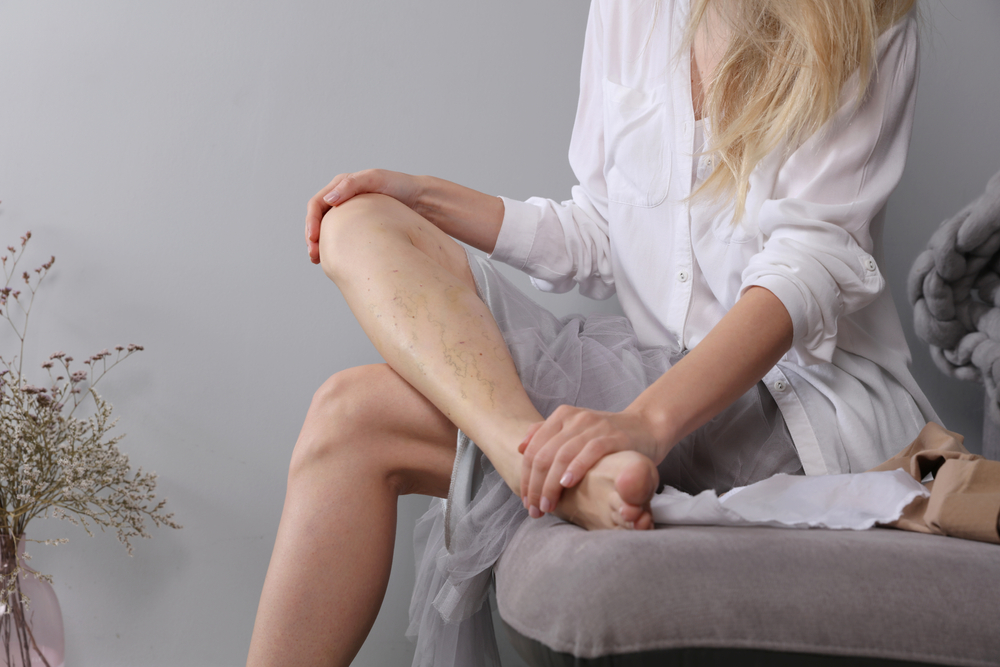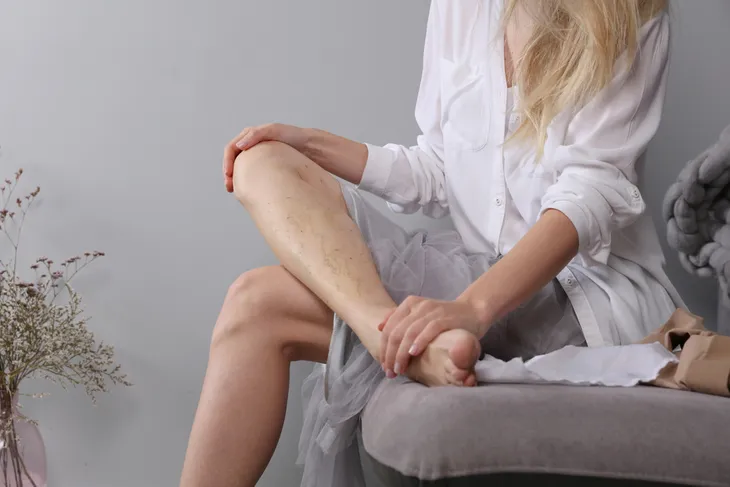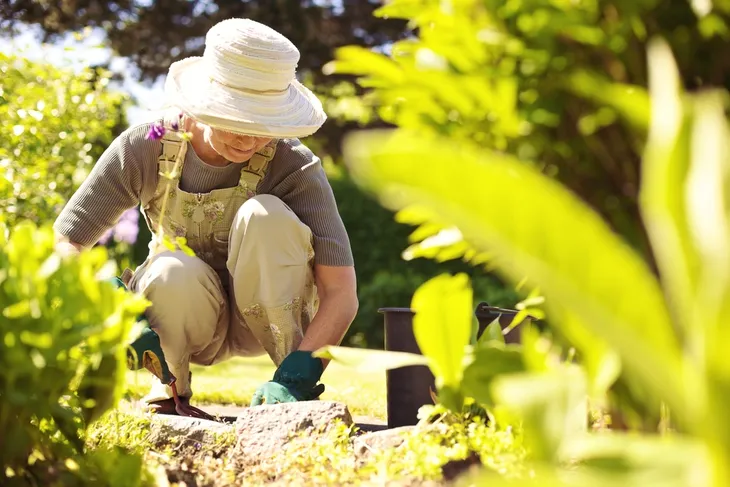Spider veins, also known as telangiectasia, are weak or damaged veins that you can see through the skin. They’re typically considered a cosmetic issue, but that doesn’t mean there aren’t reasons to treat them or prevent new ones. After all, they can make people feel self-conscious and even cause mild discomfort in rare cases. Before we dig into treating and preventing spider veins, it can help to understand the symptoms and causes.
Spider Veins vs. Varicose Veins
While some people use the terms spider veins and varicose veins interchangeably, they aren’t exactly the same. Both are veins that can be easily seen through the skin, but WebMD says spider veins are smaller than varicose veins.
Spider veins vary in color, so they may appear blue, purple, or red. Since spider veins twist and turn, some people think they look like spider webs or marble. Spider veins often appear on the legs, face, and chest.
Symptoms of Spider Veins
According to UCLA Health, spider veins typically do not cause symptoms. However, the source says spider veins occasionally cause a “dull discomfort or burning sensation.” Varicose veins, on the other hand, more commonly have noticeable symptoms.
For instance, WebMD says varicose veins often cause an aching or cramping pain in the legs. The source says varicose veins can also cause other related symptoms such as “tiredness, restlessness, burning, throbbing, tingling, or heaviness in the legs.”
Causes of Spider Veins
Even though the exact cause of spider veins is unknown, Healthline says many things can contribute to their development. For example, possible causes include:
- Sunlight
- Aging
- Genetics
- Rosacea
- Pregnancy
- Scleroderma
- Alcoholism
- Corticosteroids
Since spider veins often appear on an area of the body exposed to sunlight, the source says “chronic exposure to the sun or extreme temperatures” is believed to be a cause. Other common causes are related to conditions that weaken blood vessels and affect skin tissue.
Risk Factors for Spider Veins
Spider veins are a common condition across demographics. However, certain risk factors increase a person’s chances of developing them. According to Medical News Today, up to 90-percent of cases are in people with a family history of spider veins. The source also says spider veins affect women “almost twice as much” as men.
Aging is another risk factor since the source says 41-percent of women over the age of 50 have spider veins. Other possible risk factors include working outdoors, sitting or standing for long periods, pregnancy, medications and treatments that affect hormones, being overweight, and damage from past blood clots.
Lifestyle Adjustments That Can Help
According to the Doctors Hospital of Augusta, “Spider veins aren’t usually a cause for concern or a medical condition that needs treatment.” However, some lifestyle adjustments may help reduce the appearance of spider veins if they make you feel self-conscious.
For example, the source suggests wearing compression socks since they can “help improve blood flow” and make spider veins “less noticeable.” Additionally, it can help to stay active and avoid sitting or standing in the same position all day. And when you do sit, the source recommends elevating your feet and uncrossing your legs.
Medical Treatments for Spider Veins
If spider veins still bother you after making lifestyle adjustments, then you may want to talk to your doctor about possible medical treatments. The Doctors Hospital of Augusta says, “There are some minimally invasive procedures, which are performed by dermatologists, that can help get rid of them.”
Laser therapy is an option that may help treat tiny spider veins. “During laser therapy,” the source says, “your dermatologist will place a laser that heats the vein until its destroyed and dissolves over time — usually within several weeks.” However, laser therapy may not be effective on larger spider veins.
Sclerotherapy may be recommended when spider veins are 1- to 2-millimeters in diameter. “During the procedure,” the source says, “a dermatologist will insert a tiny needle into the vessels and inject a special salt-like chemical.” It causes the vein to swell shut and reroutes the blood to healthier veins in order to fade the appearance of spider veins.
Preventing Spider Veins
Even though genetics are linked to spider veins, certain measures may help prevent them from developing. For example, Medical News Today recommends wearing sunscreen daily because sun exposure may cause spider veins. It also recommends exercising regularly and wearing compression socks to improve circulation.
The Old Farmer’s Almanac also has practical advice for preventing spider veins. It recommends ditching high heels because they “put undue stress on your legs” and forcing yourself to move around throughout the day. The source suggests moving at least once an hour to avoid sitting or standing in one position for too long.
Exercise Ideas To Help Prevent Spider Veins
Since physical activity is such an important aspect of preventing and managing spider veins, you might wonder if any specific type of exercise is recommended. According to the Goldman Vein Institute, walking, biking, and swimming “are all good activities for getting blood circulating and promoting healthy veins.”
However, the source cautions against overdoing it with strenuous activities that put a lot of strain on your legs. As a result, the source recommends walking, biking, and swimming at a moderate pace. That way, you can get the benefits of staying active without pushing yourself too hard and straining your leg muscles.
Ways to Incorporate Even More Movement
As previously mentioned, it can help to move at least once an hour. While it isn’t realistic to bike or swim that often, there are plenty of ways to fit in short bursts of movement throughout the day. For instance, take the stairs instead of the escalator or elevator, park your car further away from the entrance, and go for a walk during lunch.
According to Shape, research shows that interrupting 30-minutes of prolonged sitting with just 2-minutes of physical activity can make a difference. So, those who dread long workouts can breathe a sigh of relief. Intermittent movement like jumping jacks and walking in place for a couple of minutes can also help prevent spider veins.
Dietary Changes That Can Help
Additionally, the Vein Clinics of America says that a few adjustments to your diet can improve vein health and may help prevent spider veins. In a nutshell, the source recommends “eating a diet full of fiber and low in salt, processed foods and sugar.”
To get more specific, Healthline says that research suggests these foods may help improve blood flow and circulation:
Quick Remedies for Spider Veins
Unfortunately, there aren’t proven quick fixes for spider veins. So, if you want to get rid of spider veins before an upcoming special event, there isn’t a product that’ll magically erase them. However, cover-up cosmetic products can help camouflage spider veins in a pinch.
In addition to body and leg makeup, Medical News Today also recommends self-tanning products to help mask and minimize spider veins. Of course, makeup and self-tanning products are only temporary fixes. But they can help if spider veins make you feel self-conscious.
The Takeaway
Spider veins are especially common in women over the age of 50. They’re usually painless, although they can occasionally cause discomfort. Even though spider veins typically don’t require treatment, some people would like to get rid of theirs because of how they look.
If spider veins make you feel uncomfortable in your own skin, then lifestyle adjustments may help reduce their appearance and prevent new ones. For instance, moderate exercise and compression socks can help improve circulation. Minimally invasive medical procedures can also help — just keep in mind that many insurance companies don’t cover treatments related to spider veins.















